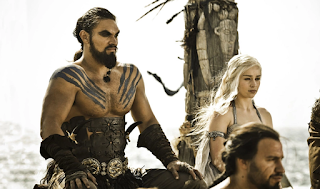Breaking Down Hyper Masculinity in Tolkien’s World Building
Breaking Down Hyper Masculinity in
Tolkien’s World Building
In Tolkien’s fantastical
worlds, there are surprisingly many reflections to our own world’s issues. Tolkien’s
world also suffers from the issues of misused-privileged power, war, racial and
social inequities, and greed. Which of course means that there is bound to be gender
discrimination and stereotypical (sometimes toxic) gender roles. Now this is
not the only case in fantasy where stereotypical gender roles are the basis for
world building. In fact, we are introduced to it at such an early age it
becomes surprising when these societal norms are challenged. Even with Tolkien’s
writing this style of character writing would not be a problem, only if it did
not impact the readers own identity and development. As humans, we base our
learning of societal norms and behaviors off of observations from the society
that surrounds us. And of course a portion of this learning comes from the books
that we read. I know for my personal experience a lot of how I identify myself
was inspired from the books I read as a child, with heroic heroines such as
Katniss Everdeen (The Hunger Games),
Mallory (The Spiderwick Chronicles),
Hermoine Granger (Harry Potter), and Meggie
(Inkheart). I was able to model my
own personality based off of their own character’s traits, and this can be said
for many other readers. This brings forward the problematic issues of children reflecting
possibly negative and toxic character traits into their own personality,
specifically with toxic masculinity. Even in Tolkien’s world building, which
has become a safe haven for many fantasy lovers and fans wanting to take a
fantastical break from their own world, there are still issues with masculinity
in his novels. Interestingly though, in Tolkien’s world building levels of masculinity
differs between species. For instance, in the Elvin cultures, males are
portrayed as very feminine characters, with porcelain white skin and excellent
bone structure. While males of other cultures, such as the Men, were created to
be the manly men with beards and swords and brutality galore. It definitely
shows a conflicting view of gender identity in Tolkien’s world. Despite the
male Elves having very feminine qualities, they are still considered more
powerful than the brutal (almost Neanderthal-like) Men who are consumed with
greed for power and wealth. As a female reader, I do not know how I would react
as an influential male reader based upon these two ideals of masculinity. I
feel like I would harmonize myself more with the Men, simply because they are
the closest thing to humans in Tolkien’s world. But despite this varying levels
of masculinity across species, there is still the idea of the man being the
hero, and the woman being the passive wife or mother. Even among the Elven culture,
where there would be powerful female elves, but they never led any actual
battles, they would just create barriers around cities to protect them from the
evil forces of Morgoth. These ideals support the idea of males always needing
to be the emotionally distant heroes who swing their swords and staffs around
in order to show dominance. I think world building of fantasy novels needs to
be changed to include varying levels of masculinity and discard the idea of traditional
gender roles in order to include and support today’s societal trends that question
one’s gender identity and beliefs.
(Look at all those manly beards)
-Sydney Jackson




Comments
Post a Comment